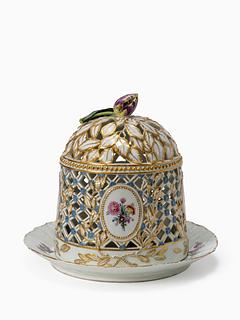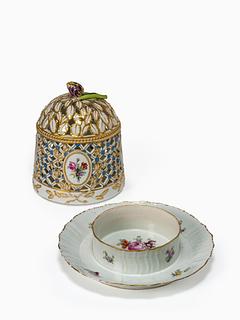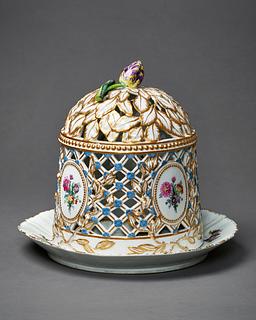Ice dish with cover; porcelain
Royal Copenhagen Porcelain Manufactory, c. 1782
H: 27 cm
Inventory number KP 54
Executed in a fluted ozier pattern, this round porcelain ice dish is decorated with Saxon flowers and accented with gold. The richly decorated cover is adorned with four oval medallions with polychrome floral bouquets. The medallions are surrounded by an openwork grid with foliage and small, blue flowers in relief. The hemispherical top is modelled with carved leaves, and its finial takes the form of a tulip bud.
At first glance, it may be difficult to imagine what practical purpose this ice dish with its beautiful cover served on the dinner tables of the nobility and the wealthy bourgeoisie. For present-day observers, it is important to remember that in the late eighteenth century, servings and dishes were presented in fixed, architectural arrangements on the table, and that the aesthetic and impressive nature of the many pieces of tableware was emphasised. In addition, the format of such dinners also imposed practical demands on the design of individual dinnerware pieces; for example, cold and hot dishes were covered by lids to maintain their proper temperature and – in the case of the ice dish – to avoid condensation.1
As the name suggests, the ice dish was used to serve ice cream, which was a highly exclusive type of dessert in the eighteenth and nineteenth centuries. The ice cream was placed in the bowl in the middle of the dish, ready to be served. After serving, the cover was put back in place. This would hide the melting leftovers while maintaining the important order and aesthetics of the overall table setting.
Another explanation to the ice dish has also been proposed; one which has nothing to do with ice cream. It suggests that the dish reflects the tradition of keeping small liqueur bottles chilled. Crushed ice was placed in the basin of the dish, and so the cover would have been purely decorative.2
The David Collection owns another ice dish with cover (KP 27), which differs greatly from the present example in both design and decoration.
At first glance, it may be difficult to imagine what practical purpose this ice dish with its beautiful cover served on the dinner tables of the nobility and the wealthy bourgeoisie. For present-day observers, it is important to remember that in the late eighteenth century, servings and dishes were presented in fixed, architectural arrangements on the table, and that the aesthetic and impressive nature of the many pieces of tableware was emphasised. In addition, the format of such dinners also imposed practical demands on the design of individual dinnerware pieces; for example, cold and hot dishes were covered by lids to maintain their proper temperature and – in the case of the ice dish – to avoid condensation.1
As the name suggests, the ice dish was used to serve ice cream, which was a highly exclusive type of dessert in the eighteenth and nineteenth centuries. The ice cream was placed in the bowl in the middle of the dish, ready to be served. After serving, the cover was put back in place. This would hide the melting leftovers while maintaining the important order and aesthetics of the overall table setting.
Another explanation to the ice dish has also been proposed; one which has nothing to do with ice cream. It suggests that the dish reflects the tradition of keeping small liqueur bottles chilled. Crushed ice was placed in the basin of the dish, and so the cover would have been purely decorative.2
The David Collection owns another ice dish with cover (KP 27), which differs greatly from the present example in both design and decoration.
Published in
Published in
Dansk porcelæn 1750-1800: udstilling i Det Danske Kunstindustrimuseum 13. April-7. Maj 1933, København 1933, cat. 358. (Title: Isklokke med fad);
Bredo L. Grandjean: ”Dansk porcelæn” in C.L. Davids Samling, Anden Del, København 1953, pp. 150, 184-185;
C.L. David: C.L. Davids Samling, København 1960, pp. 45-46;
Bredo L. Grandjean: Kongelig Dansk Porcelain: 1775-1884, København 1962, p. 231 and fig. 91, p. 113;
Verner Jul Andersen: Dansk kunst og kunsthåndværk, Davids Samling, 2. ed., København 1983, cat. 73, pp. 31-32;
Lauritz G. Dorenfeldt: Kongeligt porcelæn: brogetmalet porcelæn fra Den Kongelige Porcelainsfabrik 1775-1810, København 2016, p. 61;
Bredo L. Grandjean: ”Dansk porcelæn” in C.L. Davids Samling, Anden Del, København 1953, pp. 150, 184-185;
C.L. David: C.L. Davids Samling, København 1960, pp. 45-46;
Bredo L. Grandjean: Kongelig Dansk Porcelain: 1775-1884, København 1962, p. 231 and fig. 91, p. 113;
Verner Jul Andersen: Dansk kunst og kunsthåndværk, Davids Samling, 2. ed., København 1983, cat. 73, pp. 31-32;
Lauritz G. Dorenfeldt: Kongeligt porcelæn: brogetmalet porcelæn fra Den Kongelige Porcelainsfabrik 1775-1810, København 2016, p. 61;
Footnotes
Footnotes
1.
Several scholars point to this explanation, although it appears to be a case of confusing two different pieces. See Bredo L. Grandjean: Kongelig Dansk Porcelain: 1775-1884, Copenhagen 1962, p. 231.
2.
Ole Villumsen Krog: Flora Danica og det danske hof, Udstilling af porcelæns-, guld- og sølvservice, Christiansborg Slot, Copenhagen 1990, pp. 189–191.
Danish Ceramics
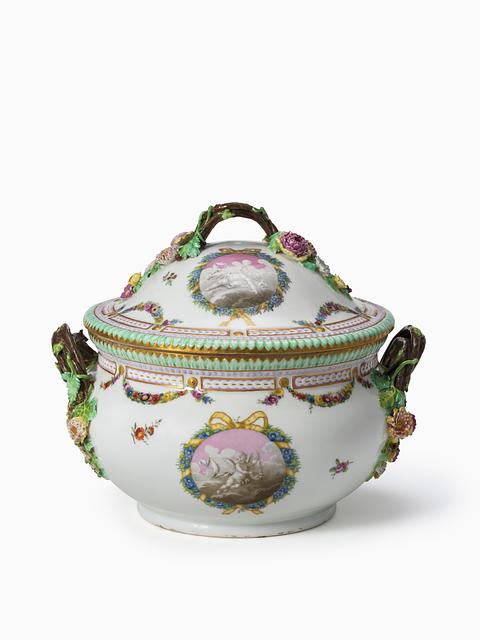
Tureen; porcelain. ‘The Holstein-Gottorp service’
Royal Copenhagen Porcelain Manufactory, 1783
Royal Copenhagen Porcelain Manufactory, 1783
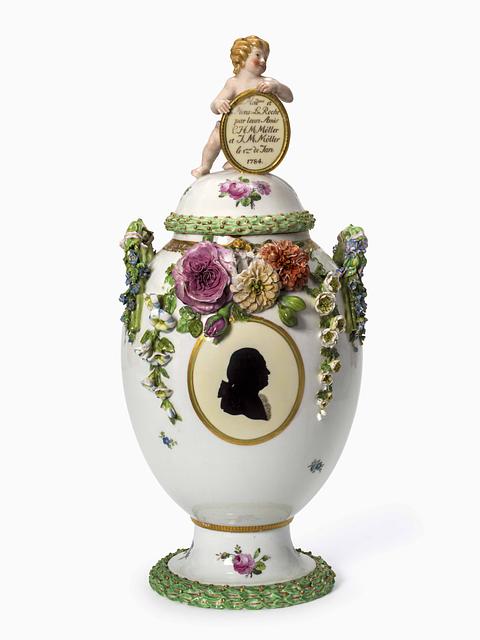
Vase; porcelain
The Royal Copenhagen Porcelain Manufactory, 1783
The Royal Copenhagen Porcelain Manufactory, 1783
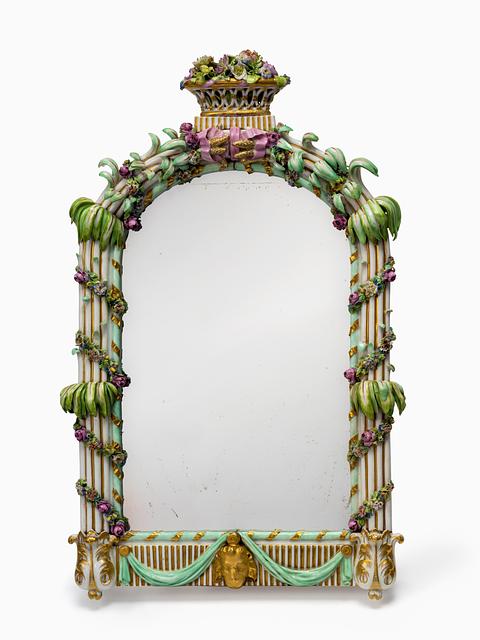
Mirror frame of porcelain
Royal Copenhagen Porcelain Manufactory, c. 1784
Royal Copenhagen Porcelain Manufactory, c. 1784
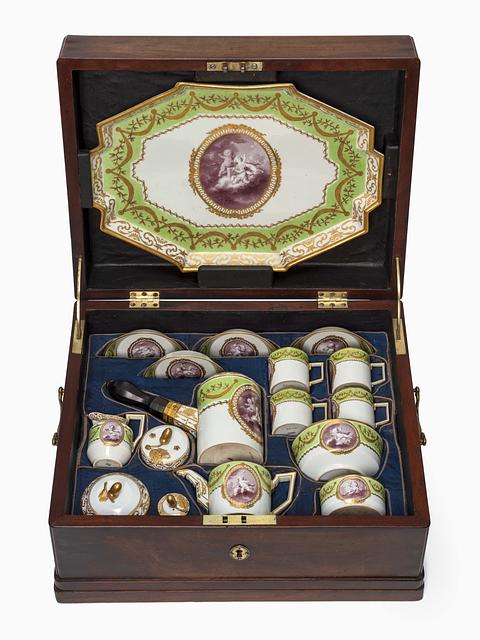
Tea set of porcelain in matching mahogany box
Royal Copenhagen Porcelain Manufactory, c. 1790
Royal Copenhagen Porcelain Manufactory, c. 1790
